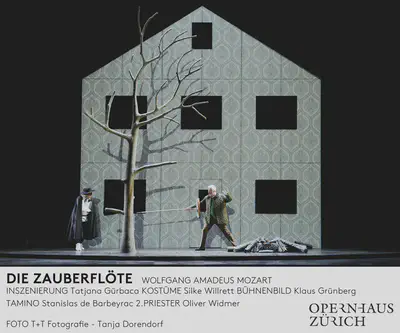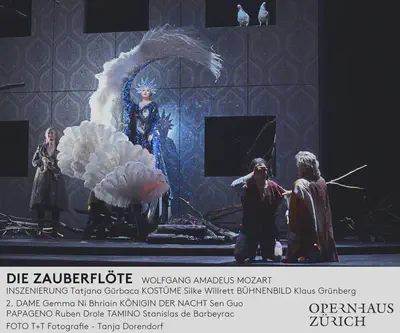Die Zauberflöte
So was sehen zu müssen, ist Höllenmarter.
Die Zauberflöte is, in my uneducated opinion, one of the most difficult operas to bring to the stage. On top of the technical challenges it poses (which are wholly manageable for any decent opera house), die Zauberflöte is among the most frequently performed of all operas, meaning one has to wow the neophyte opera-goer—who wouldn’t risk the hefty ticket price on anything not Mozart-Wagner-Verdi—and the seasoned, binoculars-clasping, loge-supervising audience, who might get bored if something on stage comes to close to any famous production from the last 230+ years. And let’s not forget the many famed arias that will inevitably draw the intense scrutiny of every spectator. Combined with the the general oniric vibe and the free-masonic imagery of the play, this can lead to some interesting choices in costume and stage directions.
To top it off, the libretto is incredibly sexist throughout, and fraught with racist stereotypes, notably the Monostatos problem: a Moor (the only dark-skinned character in the play), whose main appearances on stage include getting unjustly punished by his master, and a long aria of lamenting the hideousness of his blackness and the beauty of Pamina’s whiteness, leading to his attempted rape of Pamina. This quite disconcerting material has lead some operas to refuse to show the play altogether, to rewrite the libretto to be less offensive (which is hard, as the sexism and racism are both ubiquitous in the libretto and intimately intertwined with the plot), or at the very least conducted long consultations with experts and the public on how to contextualise the material as a product of its time.
Given all of this, I was very interested in seeing how the Opernhaus Zürich would bring die Zauberflöte on stage. Without deflowering the rest of this post, it was a hot mess, and the worst production I’ve seen in Zurich.
Crack-house meets Pirates of the Caribbean (and also live chickens?)
This performance was directed by Tatjana Gürbaca, and features the Opernhaus’ signature rotating stage (the advantages of which are still not entirely clear to me). The stage features a three-story house facade (the two upper floors being used only minimally during the play), and each housefront features a barren tree and a fireplace. The stage is often littered with trash and random debris, and the fireplace alternatively smouldering and extinguished—and sometimes converted to a makeshift barbecue using a wacky cinderblock construction, leading to what I can only describe as a crackhouse aesthetic. Perplexingly, these fireplaces are also transformed into makeshift barbecue fire pits with an elaborate cinderblock construction. Perhaps a redneck take on the free-masonic Eingeweihten? We’ll never know, and the barbecue will not be used anyway.

The costumes only reinforce this general shoddy vibe. Papageno however looks like a kid dressed as a pirate for his first birthday party, and together with the three disheveled dames gives vibes of a cheap “Pirates of the Caribbean” knock-off. The queen of the night, on the other hand, is dressed as a cancan (?) dancer draped in big, white feather fans—an interesting idea, which could have been explored more: the queen of the nightlife revealing in her “debauchery” against the bourgeois order of the Eingeweihten—, but is never seen in a similar costume again. All in all, a very confusing choice of costumes in my opinion, and a scene aesthetic that doesn’t really serve the play.
On top of being dressed in random bits and scraps of fabric, the three Dames also wear beards. Again, the significance of this choice is still a mystery to me, as it is never actually used in the play—even though one could have easily made an interesting statement about gender, especially given the mysoginistic libretto, but no such thing awaits the spectator.
This production was also supposed to feature live chicken, which I find a rather perplexing choice.
Helf’ eine mir nur aus der Noth,
Sonst gräm’ ich mich wahrlich zu Tod’.
—Papagenoverzweifelter Zuschauer
Among other oddities in the production which I cannot explain: Papagena appears to Papageno perched on one of the trees and spits a copious amount onto a table below (?), and an annoying tendency to force some standup-comedy bits in-between scenes—it happens often enough that good singers are not good actors, and it is even rarer that they are good comedians.
However, I really liked the choice of having the queen of the knight present a variety of weapons each more improbable as the other to Pamina to kill Zarastro—humourous and discreet, but still fitting to the universe of the play.
Addressing the Monostatos in the room
I almost left during the intermission, but I was curious to see how the Opernhaus dealt with Monostatos in aria 13 (the rape of Pamina). I did not have high hopes given the first half, but I thought that a differentiated Ausseinandersetzung with the character of monostatos could at least not make this any worse.
Alas, I should have known from the way the sexism in the liberator was treated—i.e., not—that Monostatos’ aria would be a disaster. And indeed, Monostatos is dressed as a primitive man, wearing a hairy fur suit under his clothes and a hirsute beard—at least we were spared a Blackface. The libretto is kept as in the original, and everything is played with the utmost lack of arrangements or even context. Even on the website, there is not a single word explaining the choice of the Opernhaus regarding their production of this scene. I’m just terribly disappointed.
Stille, Stille, Stille
Putting aside the awful content of the production, the quality of the voices is also very variable. I was annoyed from the start by the lack of exact coordination between the three Dames in the very first scene—when half of the verses end on a hard germanic /t/ sound, a coordinated tempo is of utmost importance, lest the spectator falls victim to a stuttering cascade of t-t-t’s.
Vitalij Kowaljow (Zarastro) and Thomas Erlank (Tamino) were particularly good, with a consistent and solid performance and a very natural fit to the text. Christina Poulitsi (Königin der Nach) was also quite good, but lacked both tempo and power in her crucial aria.
Mit jedem Tone meinen Dank
At least, the musical performance of the Philarmonia Zurich (dir. Nikolaj Szeps-Znaider) was very good (albeit played a little too slowly for my taste), with a special mention for the flute (even wandering around on stage in the last few scenes).
